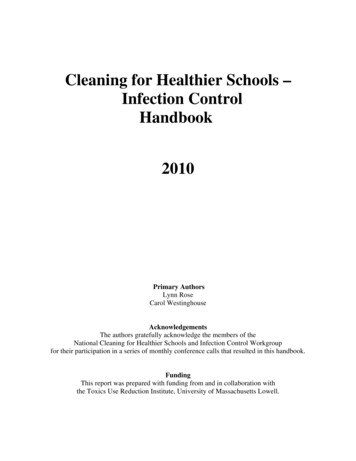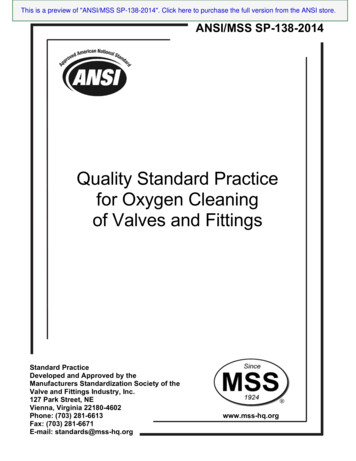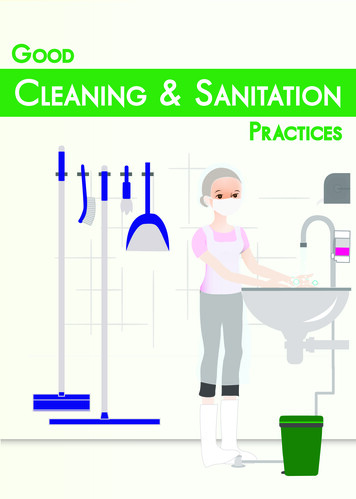
Transcription
Cleaning for Healthier Schools –Infection ControlHandbook2010Primary AuthorsLynn RoseCarol WestinghouseAcknowledgementsThe authors gratefully acknowledge the members of theNational Cleaning for Healthier Schools and Infection Control Workgroupfor their participation in a series of monthly conference calls that resulted in this handbook.FundingThis report was prepared with funding from and in collaboration withthe Toxics Use Reduction Institute, University of Massachusetts Lowell.
Participants in the National Cleaning for Healthier Schools and Infection Control Workgroup (inalphabetical order):Anila Bello, Researcher, Harvard UniversityMary Dozois, CIH, Massachusetts Division of Occupational SafetyJennifer Flattery, MPH, California Department of Public Health, Occupational Health Branch, WorkRelated Asthma Prevention ProgramThomas Fuller, ScD, CIH, MSPH, MBA, Environmental Health Program Director, Illinois StateUniversity; Consultant, Massachusetts Nurses AssociationMaxine Garbo, RN, Massachusetts Division of Occupational SafetyTolle Graham, Healthy Schools Coordinator, Massachusetts Coalition for Occupational Safety and HealthVictoria Leonard, RN, FNP, PhD, Child Care Health Consultant; Healthline Nurse, University ofCalifornia San Francisco (UCSF) California Childcare Health ProgramJason Marshall, Laboratory Director, Surface Solutions Laboratory; Toxics Use Reduction InstituteBarbara C. Mackey, BSN, MS, ANP-BC, School Infectious Disease Response Nurse and School HealthAdvisor, Massachusetts Department of Public HealthElise Pechter, MPH, MAT, CIH, Massachusetts Department of Public Health, Occupational HealthSurveillance ProgramBobbie Rose, RN, Child Care Health Consultant; Healthline Nurse, UCSF California Childcare HealthProgramLynn Rose, Consultant and Trainer, Massachusetts Facilities Administrators Association, SpringfieldDepartment of Parks, Buildings and Recreation Management, Newton Public Schools, and WorcesterPublic SchoolsLynne Sehulster, PhD, M(ASCP), Centers for Disease control and Prevention, Prevention and ResponseBranch, Division of Healthcare Quality PromotionNancy Simcox, MS, Research Industrial Hygienist, University of Connecticut Health CenterJustine Weinberg, MSEHS, CIH, Industrial Hygienist, California Department of Public Health,Occupational Health Branch, Work-Related Asthma and Occupational Pesticide Illness PreventionProgramsCarol Westinghouse, President, Informed Green Solutions, Inc.; Program Manager, Cleaning for Healthii
Contents1. Introduction to the HandbookPageA. Introduction1B. Handbook Definitions62. The Science of Infection Control113. Development of ProtocolsA. Introduction: Writing a Procedure for Disinfection20B. Choosing the Right Level of Microbe Control21C. Managing Surfaces for Infection Control23D. Dispensing Disinfectants30E. Labeling Secondary Containers31F. Precleaning Surfaces and a Discussion on Using Cleaner/Disinfectants33G. Identifying Factors That Compromise Disinfectant Efficacy35H. Preventing Cross-Contamination38I. Storing Disinfectants42J. Disposal of Disinfectant and Biological Wastes44K. Taking Precautions: Using Personal Protective Equipment46L. Preparing to Respond to a Chemical Exposure49M. Assigning Roles and Responsibilities and Educating School Staff514. Selection of Products, Dispensing Equipment, and Application SystemsA. Introduction56B. Comparing Disinfectants: Comparison Chart for Hard-SurfaceDisinfectants Registered by the Environmental Protection Agency59C. Using the Disinfectant Label Information to Make Informed Decisions69D. Interpreting Information from Hazardous Materials Rating Systems forProduct Selection71E. Using Information from Hazardous MaterialsRating Systems for Product Selection72F. Using Information from Material Safety Data Sheets for Product Selection 73G. Selecting a Disinfectant Application System75H. Choosing Between Concentrated Products and Ready-to-Use Products81I. Selecting and Installing Product-Dispensing Systems84iii
5. Safe Use PracticesPageA. Introduction86B. Using Bleach (Sodium Hypochlorite): Hazard Overview87C. Protocol for Safe Use of Bleach90D. Using Disinfectants936. Equipment for Infection ControlA. Introduction94B. Using Devices to Eliminate Chemical Use: Ionator, SteamTechnology and Hands-Free Technology96C. Using Microfiber Cloths and Mops for Infection Control102D. Using Ventilation to Help Reduce Disease Transmission106Appendix A: Development of Protocols1. Cleaning for Healthier Schools: Best Practices1082. Cleaning for Health: Program Components Checklist1093. Program Planning Handout: Cleaning for Healthier Schoolsand Infection Control1114. Regulatory Categories and Definitions of Waste1205. Understanding Hand Hygiene122Appendix B: Selection of Products, Dispensing Equipment, and Application Systems1. Green Product Certification and Labeling: Quick Reference1262. Interpreting the Disinfectant Label: Explanation and Examples1283. Interpreting Information from Hazardous Materials Rating Systems:National Fire Protection Association and HazardousMaterials Information System1354. Environmental Protection Agency Toxicity Categoriesfor Precautionary Statements1385. Selecting Disinfectants for Hard Surfaces: Checklist141iv
Appendix C: Sample Classroom, Nurse, and Custodial Guidelines and PostersPage1. Sample Policy: Classroom1432. Sample Work Practice Poster: Cleaning Surfaces forInfection Control for School Custodians1453. Sample Policy: School Nurse1464. Sample Protocol Poster: Cleaning Up Blood and Body-Fluid Spills1485. Sample Memo: Blood Spill Kit150Appendix D: Resources1. Organizations1512. National Cleaning for Healthier Schools and Infection ControlWorkgroup Contact List156v
Chapter 1: Introduction to the HandbookChapter 1.A. IntroductionGoal and Purpose of the Cleaning for Healthier Schools – Infection Control HandbookThis Handbook is designed to provide information that will enable schools to develop andimplement effective infection-control practices while minimizing the use of, and exposure to,toxic products. The material is intended to be used by school personnel, including facilitymanagers, head custodians, administrators, nurses, and purchasing agents, when customizingtheir school program.The Handbook has been developed over several years by the National Cleaning for HealthierSchools and Infection Control Workgroup, which consists of representatives from the academic,public health, environmental health, medical, and school advocacy communities.The Workgroup has found that a thorough, ongoing cleaning program is the best strategy toprevent disease transmission, with sanitization and disinfection activities playing only a part ofthe strategy in very specific situations. Following good cleaning procedures on a daily basis isconsidered a best practice and will reduce the need for disinfectants as well as the transmissionof many diseases.The purpose of this Handbook is to1. Educate the purchasers and users of disinfectants about (a) the health and environmentalimplications associated with using and misusing these products, (b) when disinfection isnecessary, (c) proper disinfecting techniques, (d) the choices of disinfectants, (e) the criteriafor selecting safer disinfectants, and (f) proper procedures for protecting the health of productusers and building occupants.2. Provide the tools needed for schools to create their own policies and protocols.3. Provide information on the differences between cleaning, sanitizing, and disinfecting andwhen it is appropriate to use each methodology.Limits of the HandbookThe Handbook provides basic information about the transmission of disease from pathogenicbacteria, fungi, and viruses, as well as related infection-control strategies (of which disinfectionis one tool) to frame the discussion of disinfection. Because it does not address specific diseasesfound in school settings, the Handbook is designed to enhance a school’s infection-controlprogram, not replace it.Diseases and other health conditions that are not controlled through cleaning and disinfectionpractices in schools—such as sexually transmitted diseases, parasites (worms, scabies, lice),mosquito-borne illness, bites, and so forth—are not addressed in this Handbook. Although theresponse of many people to an outbreak of parasites is to disinfect, disinfecting is not anappropriate control strategy.Introduction to the IssueProtecting public health in a school building is a complicated issue. The time allowed for generalcleaning tasks is constantly being reduced because of budget constraints and other competingneeds. At the same time, there is a growing belief on the part of parents and school staff that all1
Chapter 1: Introduction to the Handbookgerms (referred to herein as “microbes”) need to be killed because of infectious-diseaseoutbreaks in schools and other public places. This belief and the lack of time for routine cleaningand hand hygiene leads to the indiscriminate use of sanitizers, disinfectants, and antimicrobialhand products that may pose a hazard to staff, students, and the environment.The Environmental Protection Agency (EPA), the federal agency that regulates and registersdisinfectants and sanitizers, reports that a billion dollars a year are spent on disinfectants andantimicrobial products. This figure illustrates the enormity of the industry and of product usage.Disinfectants are not cleaners but pesticides designed to kill or inactivate microbes. Thus, theyare not products that should be used indiscriminately. The overuse and misuse of these productsis a growing public health and environmental concern. Studies have found that the use of somedisinfectant products is creating microbes that can mutate into forms that are resistant toparticular disinfectants or that become superbugs.1–3 Incorrectly using a disinfectant—such aswiping or rinsing the solution off the surface before the recommended dwell time, not using therecommended dilution ratio, or using a combination disinfectant/cleaner when there is more dirton a surface than the disinfectant can handle—may enable the bacteria that survive to mutate intothese superbugs.Understanding the IssueThere is a common misunderstanding in the general public about the role that bacteria, fungi, andviruses play in human health. Many people do not understand that microbes have both beneficialuses and negative impacts. Product manufacturers sometimes design media messages about theproliferation of germs and their potential health affects so as to cause public alarm and increasethe desire for antimicrobial products.In addition, the indiscriminate and interchangeable use of the terms sanitization and disinfectionin some regulatory mandates on the type of products required for specific tasks in health care andearly care and education settings often adds to the confusion regarding the level of microbecontrol that is required. These terms represent different levels of microbe control on differentsurfaces, and the EPA uses these terms to specify which products can be registered for each use: Disinfectants: used on hard, inanimate surfaces and objects to destroy or irreversiblyinactivate infectious fungi and bacteria, but not necessarily their spores.Sanitizers: used to reduce, but not necessarily eliminate, microorganisms from theinanimate environment to levels considered safe, as determined by public health codes orregulations.As a result of these misconceptions, the overuse and inappropriate use of these products poses adaily health risk. School cleaning programs must control the risk of the spread of infectiousdisease while simultaneously protecting the health of the custodial staff and building occupantsfrom the health effects of using disinfectants made of powerful and sometimes toxic orhazardous chemicals.Health IssuesIt is well documented that disinfectants are associated with both acute and chronic healthproblems. In a recent study of cleaning products and work-related asthma, Rosenman andcolleagues found that 12% of confirmed cases of work-related asthma were associated withexposure to cleaning products. Of these cleaning-related cases, 80% (4 out of 5) were new-onsetcases (i.e., the cleaning product exposures caused new asthma in people who had not had it2
Chapter 1: Introduction to the Handbookbefore). Of all the cleaning-related asthma cases, 39% were from medical settings, but 13% werefrom schools. In all work settings, 22% of those who had work-related asthma associated withcleaning agents worked as cleaners.4Another study found that cleaning-product ingredients reported in work-related asthma casesincluded irritants such as acids, ammonia, and bleach, and disinfectants such as formaldehyde,glutaraldehyde, and quaternary ammonium compounds (QACs).5 Emerging science links QACswith reproductive problems as well.6Environmental Issues That Become Health IssuesResidues of disinfectants that are washed down our drains and into our sewage treatment plantsand rivers are triggering the growth of drug-resistant microbes. When the sludge filtered fromtreated sewage is spread on farm fields, soil samples from these fields have been found tocontain high levels of bacteria with antibiotic-resistant genes. The presence of such bacteria maybe due to the fact that although QACs kill nearly all microbes when used correctly, when usedincorrectly, they can create resistant bacteria at the surviving low levels found in sludge andwater samples.7 The resistant bacteria can result in antibiotic-resistant diseases like methicillin resistant Staphylococcus aureus (MRSA).Disinfection as Part of a Cleaning for Healthier Schools ProgramThis Handbook is designed to be used as part of a Cleaning for Healthier Schools program thatfocuses on the thorough cleaning of surfaces, particularly “high-risk” or “high-touch” areas, andthe on targeted use of disinfectants and sanitizers for an infection-control strategy: High-touch areas: surfaces touched frequently and by a variety of hands over the courseof the day. High-touch areas include door handles, faucet handles, handrails, shareddesks, push bars, drinking fountains, and so forth. Areas touched by only one person,such as a personal computer keyboard, do not pose the same risk.High-risk areas: locations where there is a higher risk for bloodborne incidents, skincontact (MRSA risk), or contact with feces and body fluids. Examples of high-risk areasinclude the nurse’s office, athletic areas, and childcare centers.Infection Control: A Three-Pronged StrategyThis strategy provides three methods for integration by the user, based on the most effective andleast hazardous methods to use for each situation.1. Personal Hygiene Strategies for Microbe Control. Hand and respiratory hygiene andcough and sneeze etiquette are key personal hygiene strategies that help to reduce thespread of some types of infectious diseases. This infection-control method involvesfacilitating an education program on hand hygiene that teaches and requires frequenthand washing and proper cough and sneeze procedures. This effort also involvesproviding hand-washing facilities and adequate time for hand washing. See Appendix A.5Understanding Hand Hygiene for specific information. Posters, free and easily availablefrom the CDC Web site (http://www.cdc.gov/flu/protect/stopgerms.htm), encourage theseactivities and can be mounted throughout the school as part of an infection-controlprogram.2. Cleaning for Microbe Control. Comprehensive cleaning programs that use less-toxicproducts and updated tools and technology can help control the spread of infectious3
Chapter 1: Introduction to the Handbookdisease. This infection-control method involves removing the majority of the microbesand the conditions they need to survive and thrive. Frequent cleaning of high-touch areaswith a third-party-certified (e.g., Green Seal, EcoLogo) all-purpose detergent and amicrofiber cloth is considered by experts to be sufficient to reduce the number of germsor pathogenic microbes on most surfaces to an acceptable level for public health.Research from the Centers for Disease Control and Prevention states that large numbersof microorganisms can be removed by “the physical action of scrubbing with detergentsand surfactants and rinsing with water.8 Using high-quality microfiber cloths and mops aspart of your a cleaning program enhances this process, because studies show thatmicrofiber is superior at capturing microbes.93. Disinfecting and Sanitizing for Microbe Control. This infection-control strategyinvolves a targeted disinfection and sanitizing program that is designed to address highrisk areas, meet regulatory requirements, and respond to special events or incidents inwhich there is a specific biological hazard. Only trained staff using approved productsshould perform designated disinfecting and sanitizing tasks.Recommendations on How to Use the HandbookWhen developing a disinfection policy and related work practices, the Workgroup recommendsthat schools or school districts form or use an existing stakeholder group to explore andcustomize the materials in the Handbook. A school stakeholder group should includerepresentation, at a minimum, from the administration and from the facilities, nursing, athletic,food service, and teaching staff. Based on the outcome of this collaboration, the school systemwill need to provide infection-control training, policies, protocols, and posters; a list of approveddisinfectants; and a schedule for cleaning and disinfecting. The school should also designatetrained staff for specific tasks.Common ChallengesWhile providing technical assistance to schools regarding their cleaning programs, members ofthe Workgroup found a general lack of training in the use of disinfectants. There is also atremendous amount of pressure from parents and others to use disinfectants because they thinkthis will protect the students and staff from communicable diseases. Following a written protocolcan reassure staff, students, and parents that the school is taking the steps necessary to controlinfectious diseases.The following challenges may need to be addressed when developing the protocol: Confusion on the part of staff about the differences between cleaning, sanitizing, anddisinfecting and when to use each type of process and product The lack of training for teachers and staff on the correct usage and storage ofdisinfectants The pros and cons of providing teaching staff with school-approved disinfectants The lack of information on the effectiveness of third-party-certified cleaners used withmicrofiber cloths and mops as an alternative to disinfecting4
Chapter 1: Introduction to the HandbookReferences1. S. Gundheim, S. Langsrud, E. Heir, et al, “Bacterial Resistance to Disinfectants ContainingQuaternary Ammonium Compounds.” International Biodeterioration & Biodegradation 41, no.3–4 (1998): 235–9.2. A.E. Aiello and E. Larson, “Antibacterial Cleaning and Hygiene Products As an EmergingRisk Factor for Antibiotic Resistance in the Community.” The Lancet Infectious Diseases 3, no.8 (2003): 501–6.3. A.K. Mangalappalli-Illathu and D.R. Korber, “Adaptive Resistance and Differential ProteinExpression of Salmonella enterica Serovar Enteritidis Biofilms Exposed to BenzalkoniumChloride.” Antimicrobial Agents Chemotheraphy 50 (2006): 3588–96.4. K. Rosenman, M. Reilly, D. Schill, et al, “Cleaning Products and Work-Related Asthma.”Journal of Occupational and Environmental Medicine 45, no. 5 (May 2003): 556–63.5. J.M. Mazurek, M. Filios, R. Willis, et al, “Work-Related Asthma in the Educational ServicesIndustry: California, Massachusetts, Michigan, and New Jersey, 1993–2000.” American Journalof Industrial Medicine (2007) Available at: A EdServices.pdf.6. B. Maher, “Lab Disinfectant Harms Mouse Fertility.” Nature News 453, 964 (2008) doi:10.1038/453964a. Published online. Available at: a.html.7. W. Gaze, “Is Pollution Driving Antibiotic Resistance?” Planet Earth Online, EnvironmentalResearch News. Natural Environment Research Council. (2008) Available px?id 207.8. L. Sehulster and R.Y.W. Chinn. “Guidelines for Environmental Infection Control in HealthCare Facilities: Recommendations of CDC and the Healthcare Infection Control PracticesAdvisory Committee (HICPAC).” Morbidity and Mortality Weekly Report 52, no. RR10 (2003):1–42. Available at: ro guide 03.pdf.9. Environmental Protection Agency, Using Microfiber Mops in Hospitals, Environmental BestPractices for Health Care Facilities November 2002. Region 9 Pollution Prevention Program.Available at: tal/mops.pdf.5
Chapter 1: Introduction to the HandbookChapter 1.B. Handbook DefinitionsTermsAccelerated hydrogen peroxide – hydrogen peroxide in synergy with a blend of commonlyused ingredients that accelerate the disinfectant activity.Acute – health conditions characterized by sudden onset and of finite duration. In addition, theytend to severely restrict the subject’s usual daily activities. The sudden-onset health effects—such as rashes, breathing problems, or headaches—are felt or noticed almost immediately, oftenwithin minutes or hours after exposure to a product or environment.Antibiotic – a medicine designed to kill or slow the growth of bacteria and some fungi.Antibiotics are commonly used to fight bacterial infections but cannot fight infections caused byviruses.Antibacterial – a term used to describe substances that kill or slow the growth of bacteria whentreating human and environmental surfaces, including those that aid in proper hygiene. Examplesof antibacterial-containing commercial products include hand soaps, gels, and foams, anddishwashing detergents.Antimicrobial – a general term used to describe substances (including medicines) that kill orslow the growth of microbes. Examples of antimicrobial agents include the following: Tetracycline (an antibiotic that treats urinary tract infections)Oseltamivir or Tamiflu (an antiviral that treats the flu)Terbinafine or Lamisil (an antifungal that treats athlete’s foot)Antimicrobial pesticide – any chemical substance that can be used to kill microorganisms.These products are used to disinfect and sanitize, and to reduce the growth or development ofmicrobiological organismsAntiseptics and germicides – substances used to prevent infection on living tissue by inhibitingthe growth of microorganisms. Because these products are used in or on living humans oranimals, they are considered drugs and therefore regulated by the Food and Drug Administration.Asthma – a chronic inflammatory disease that results from a complex interplay betweenenvironmental and genetic factors. The disease causes inflammation, with recurrent episodes ofwheezing, chest tightness, cough, shortness of breath, and/or difficulty breathing. After asthmadevelops, the airways of the lungs become more responsive to a variety of stimuli. If leftuntreated, the resulting inflammation may lead to irreversible changes in the structure of thelung.Asthmagens – substances capable of causing new-onset asthma. The Association ofOccupational and Environmental Clinics (AOEC) has established criteria for determiningwhether a substance is an asthmagen.Bacteria – microorganisms that are found on our skin, in our digestive tract, in the air, and in thesoil. Most are harmless (nonpathogenic). Many are helpful because they occupy ecological6
Chapter 1: Introduction to the Handbookniches (both within our bodies and in the external environment) that could be occupied byharmful (pathogenic) bacteria. These helpful strains keep harmful microorganisms in check.They also help our digestive system to function effectively and stimulate the development of ahealthy immune system. Beneficial bacteria are also used in the fermentation process that createsbread, wine, cheese, yogurt, and other foods and beverages.Bactericide – a pesticide used to control or destroy bacteria, typically in the home, in schools, oron hospital equipment.Chronic – health conditions in which the onset may not be noticed and characterized by agradual progression of symptoms or by problems of a more permanent nature resulting from aseries of acute conditions. Daily activities may or may not be restricted during any given period,although there is usually a more general series of activity limitations.Cleaning – the removal of foreign material (e.g., soil and organic material) from surfaces andobjects, normally accomplished with detergents or soaps. Cleaning is required prior todisinfection processes for them to be most effective.Corrosive – a corrosive material is a highly reactive substance that causes obvious damage toliving tissue. Corrosives act directly by chemically destroying the tissue (oxidation) or indirectlyby causing inflammation. Acids and bases are common corrosive materials and are sometimesreferred to as caustics. Typical examples of acidic corrosives are hydrochloric (muriatic) acidand sulfuric acid. Typical examples of basic corrosives are sodium hydroxide (lye) andammonia.Detergent – a substance that aids in the removal of dirt. Detergents act mainly on the oily filmsthat trap dirt particles. Detergent molecules have a hydrocarbon portion that is soluble in oil andan ionic portion that is soluble in water. Bridging the water and oil phases, the detergent acts asan emulsifier, breaking the oil into tiny droplets and suspending them in water. The disruption ofthe oil film allows the dirt particles to be washed away.Disinfectant – a chemical or physical agent used on hard inanimate surfaces and objects todestroy or irreversibly inactivate vegetative microorganisms, viruses, and infectious fungi andbacteria, but not necessarily their spores.Disinfection – a process that is used to reduce the number of viable microorganisms on a surfacebut that may not necessarily inactivate all microbial agents (e.g., spores and prions).Efficacy – a measure of the ability to achieve desired results. Disinfectants are registered fortheir ability to kill certain microbes, and efficacy in this case relates to the percentage of targetmicrobe(s) that are killed or removed.Endocrine disruptor – an external agent that interferes in some way with the role of naturalhormones in the body. Such an agent might disrupt the endocrine system by affecting any of thevarious stages of hormone production and activity; for example, by preventing the synthesis ofhormones, by directly binding to hormone receptors, or by interfering with the naturalbreakdown of hormones.7
Chapter 1: Introduction to the HandbookEnvironmental Protection Agency Registration Number (EPA Reg. No.) – a two-partnumber assigned by the EPA to identify the pesticide product registration (e.g., 1253-79) thatmust appear on a product’s label. The first number is the company number and the secondnumber (after the dash) is the product number.Fecal coliform bacteria – bacteria found in the intestinal tracts of mammals. When present inwater or sludge, it is an indicator of pollution and possible contamination by pathogens.Fungus – a plant that has no leaves, flowers, or roots. Examples of fungi (or funguses) aremushrooms, molds, mildews, and yeasts.Microbe – a collective name for microscopic organisms including bacteria (e.g., Staphylococcusaureus), viruses (e.g., influenza A and B, which cause the flu), fungi (e.g., Candida albicans,which causes some yeast infections), and some parasites (e.g., Toxoplasma species, which causetoxoplasmosis).Microbial pesticides – microorganisms that are used to kill or inhibit pests such as insects orother microorganisms. Sometimes these microbes are effective simply by increasing in number,using the pests’ food supply, and invading their environment.Microorganisms – bacteria, yeasts, simple fungi, algae, protozoans, and a number of otherorganisms that are microscopic in size. Most are beneficial, but some produce disease. Others areinvolved in composting and sewage treatment.Pathogen – any organism or infectious agent capable of causing disease or infection.Pesticide – a substance intended to repel, kill, or control any species designated a “pest,”including weeds, insects, rodents, fungi, bacteria, or other organisms. The family of pesticidesincludes herbicides, insecticides, rodenticides, fungicides, and bactericides.Pesticide residue – pesticides that may remain on or in the plant, food crop, soil, container,equipment, handler, and so forth, after application of the pesticide.Quaternary ammonium compounds (QACs or quats) – chemicals that have a similarchemical structure and are known for their disinfectant and detergent properties. Quats are theactive ingredients in many disinfectant products used in schools. They are effective against somebacteria, viruses, fungi, and algae. Product labels specify the microbes they target. One exampleof a QAC is benzalkonium chloride.Registrant – a pesticide manufacturer that has registered a pesticide product.Registration – a formal listing with the EPA of a new pesticide before its sale or distribution.The EPA is responsible for premarket licensing of pesticides on the basis of data thatdemonstrate that there are no unreasonable adverse health or environmental effects when appliedaccording to approved label directions.Respiratory sensitizer – a substance that induces hypersensitivity of the airways followinginhalation of the substance.8
Chapter 1: Introduction to the HandbookSanitizer – a product used to reduce (but not necessarily eliminate) microorganisms (usuallybacteria) in the inanimate environment to levels considered safe, as determined by public healthcodes or regulations. Sanitizers include food-contact and non-food-contact products.Sensitizer – a substance that can pr
Appendix C: Sample Classroom, Nurse, Page . 1. Sample Policy: Classroom 143 2. Sample Work Practice Poster: Cleaning Surfaces for Infection Control for School Custodians 145 3. Sample Policy: School Nurse 146 4. Sample Protocol Poster: Cleaning Up Blood and Body-Fluid Spills 148 5. Sample Memo: Blood Spill Kit 150. Appendix D: Resources . 1.










